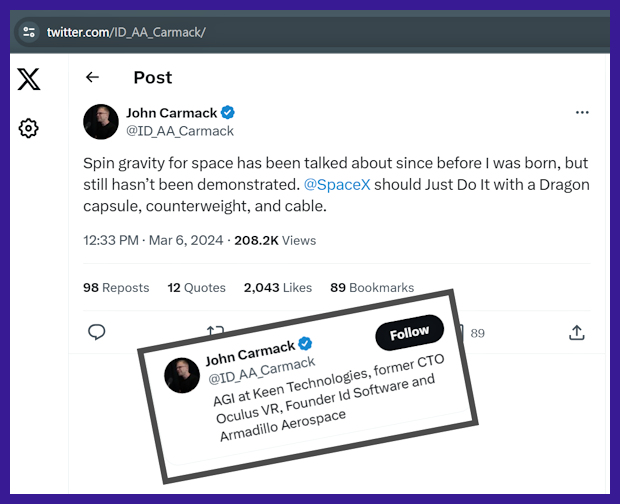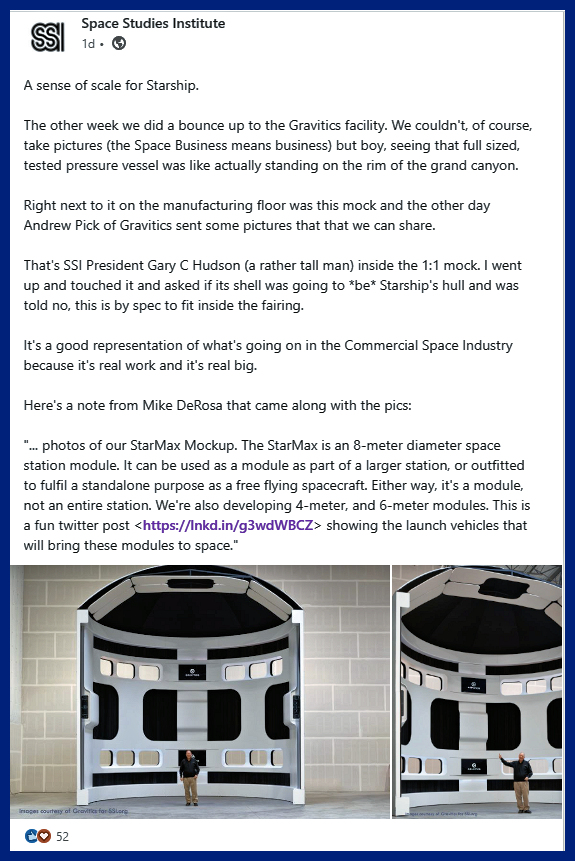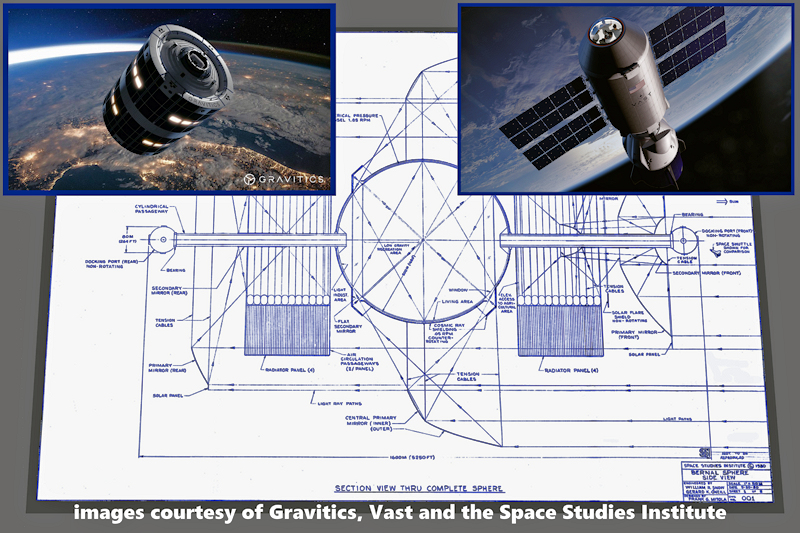
Gary C Hudson, President, Space Studies Institute
A Hudson HeadsUp
My late colleague Bevin McKinney, one of the pioneers of NewSpace, was fascinated by “spinning things.” That obsession led to our jointly founding Rotary Rocket Company, an obscure diversion on the path to reusable space transportation, but will be reborn as humanity finally comes to it senses and begins the development of spin gravity space stations and settlements. “Spinning things” are our future in space.
Years of Space Studies Institute efforts behind getting real hardware into space to test the realities of various reduced gravities (less than Earth’s 1G, but more than microgravity) are beginning to pay dividends. There are currently several companies – firms with real financial abilities – poised to put spin-gravity to the test on vertebrates in the next decade. This is a major movement in the right direction and is partly the result of SSI’s nagging our community to pay attention to this neglected field of space study. [1]
In Washington State, the NewSpace company Gravitics [2] was founded in 2021 to design and manufacture spin gravity space stations, while in California, another similar venture, Vast, was also stood up in 2022. The latter venture has announced plans to launch Haven-I, a zero-G private space station sometime after August of 2025, on a Falcon 9, but they also have ambitions to develop rotating space station technology. No doubt, more ventures and projects will soon follow.
Why hasn’t spin gravity received more serious attention in the half century since Apollo and the formation of SSI? Pretty clearly, as explained to me by those in the know at NASA and in the industry, NASA’s focus post-Apollo has been on reprising the “flags and footprints” mentality that fueled the moon landing sprint in the 1960s.
A more sinister but not (in my opinion) inaccurate view of the politics around the question of spin gravity and NASA is that the agency actively opposed any efforts, both internal or external to the organization, to avoid having to deal with the perceived programmatic risks of developing spinning systems.
Yet it is also the case that the technological challenges are significant, truly. By necessity, spin gravity stations and settlements need to be large space structures, and there are issues of spin balance, access to, and safety in, spinning stations. These challenges will not be resolved until the late 2030s and only then if we start now to mitigate the risks. This issue was behind my proposals over the past ten years, to advance our understanding of the effects of both partial gravity and spin gravity on vertebrates by establishing a “G-lab” to begin to answer these concerns.
A broader question that is usually asked is: why does spin gravity matter?
The answer, unlike the solution, is pretty simply stated. We have become adept at providing the necessary conditions for survival of humans in the vacuum of space and are making inroads into doing the same on the Moon or Mars. But we need to do more than survive to build a human civilization on the High Frontier. We need to thrive. To do so, we need families, not “Ironman” astronauts, to live and work in space or on planetary surfaces. This ambition is no longer outrageous to promote. The most successful of all NewSpace ventures, SpaceX, has as their founding principle the stated goal of colonizing the Red Planet, for example.
Almost everything humans need to live and work on the space frontier can be provided by modern technology. Power, food, water, oxygen, waste removal and recycling, radiation protection – all these save one. Gravity. We have no trustworthy scientific data that suggests we can live for extended times in the absence of a full one G of drag on our bodies. We have even less data to suggest any ability to reproduce and rear children to mature adults in partial or no gravity. We can’t change the gravitational attraction of any of the bodies in the Solar System by even a milli-G, let alone provide the full one G that is likely necessary for optimum health.
But we can provide a fairly faithful simulation of one G, by spinning our space stations and settlements, as has been known since before the dawn of the space age. It is not a perfect solution (Coriolis force effects must be taken into account) but it is all we have.
Time’s a wastin’. Let’s get to it.

Gary C Hudson
President, Space Studies Institute
[1] Not that SSI should hog credit – Joe Carroll and Jon Goff led the way in the mid 2000’s, calling attention to the lack of research around the problem of how much gravity is enough? See: https://www.thespaceshow.com/guest/joe-carroll and https://selenianboondocks.com/2010/11/variable-gravity-research-facility-xgrf/
[2] Full disclosure: I was one of the Gravitics co-founders and at my request SSI received a gift of stock in the venture for our work on promoting spin gravity and space settlement.

John Carmack notes the need on X. Thanks John!

Spin. The Gravitics Module.
See it big on SSI LinkedIn.
See it big on SSI Facebook.
Want to know more about Spin Gravity and the very important reasons for it? There’s a growing special section on it, here on ssi.org


